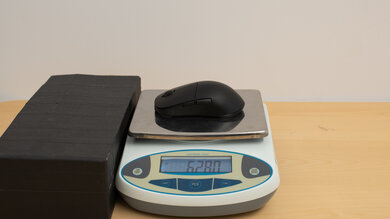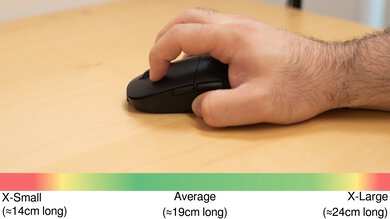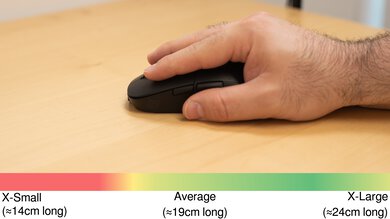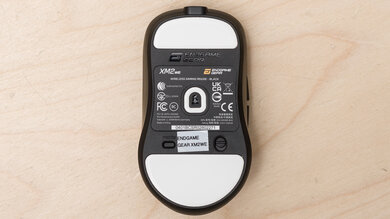The Endgame Gear XM2we is a lightweight, wireless gaming mouse positioned as a budget version of Endgame Gear's upcoming XM2w, a successor to their previous release, the wired-only Endgame Gear XM1r. The XM2we has an identical shape compared to the XM1r and uses the same PixArt 3370 sensor. Impressively, despite adding wireless connectivity, it's also slightly lighter. Additionally, this mouse introduces new Kailh GO optical switches, which are advertised to have a longer life span and aren't prone to developing double-clicking issues over time like standard mechanical switches.
Our Verdict
The Endgame Gear XM2we is satisfactory for work but not designed specifically for this use. That being said, it has excellent build quality, and you can reprogram buttons using the lightweight configuration software. This mouse connects wirelessly, but it doesn't support Bluetooth or multi-device pairing, and, unfortunately, the scroll wheel lacks L/R tilt functions and doesn't have a free-scrolling mode.
-
Excellent build quality.
-
No support for Bluetooth or multi-device pairing.
-
Scroll wheel lacks L/R tilt inputs and a free-scrolling mode.
The Endgame Gear XM2we is a fantastic FPS gaming mouse with excellent build quality and a comfortable, symmetrical shape ideal for a claw or fingertip grip for most hand sizes. It has very low click latency and outstanding overall sensor performance, delivering an extremely consistent and responsive-feeling experience in-game. It's also quite lightweight and has large, high-quality feet that glide smoothly on mousepads and desks.
-
Excellent build quality.
-
Lightweight.
-
Excellent click latency.
-
Outstanding sensor accuracy.
-
Outstanding sensor latency.
The Endgame Gear XM2we is good for MMO gaming but doesn't have nearly as many side buttons as a dedicated MMO gaming mouse. That said, you can reprogram any of its buttons using the configuration software. It also has excellent build quality, outstanding all-around sensor performance, and very low click latency— providing a responsive and reliable in-game experience.
-
Excellent build quality.
-
Excellent click latency.
-
Outstanding sensor accuracy.
-
Not nearly as many side buttons as a dedicated MMO gaming mouse.
The Endgame Gear XM2we offers exceptional raw performance. It has excellent click latency, and its sensor provides remarkably consistent motion and accuracy performance that closely translates the physical movements you make with your mouse into the cursor movements you see on screen.
-
Excellent click latency.
-
Outstanding sensor accuracy.
-
Outstanding sensor latency.
- 7.2 Work
- 9.0 Video Games (FPS)
- 7.8 Video Games (MMO)
- 9.3 Raw Performance
Changelog
-
Updated Mar 28, 2025:
We've added a note in the Build Quality section and a disclaimer to the Mouse Wheel section as we've encountered higher-than-expected reports from the community regarding potential scroll wheel failures.
-
Updated Feb 05, 2025:
We've added a link to the newly reviewed Endgame Gear XM2w 4k to the Main Button section.
- Updated May 02, 2024: We've mentioned the newly-reviewed Endgame Gear OP1we in the Hand Size Recommendation section of this review.
- Updated Jan 05, 2024: We've updated the CPI graph displayed in the Sensor Latency section of this review. Our results remain the same, but these graphs have two new columns with results from the Delay At Half Movement and Delay To End Of Movement tests.
- Updated Oct 03, 2023: We've corrected an error in the In the Box section of this review. Previously, this section indicated this mouse had a USB-C wireless receiver. It now correctly lists that it has a USB-A wireless receiver.
Check Price
Differences Between Sizes And Variants
The Endgame Gear XM2we is available in a Black or White color option, but no other variants are available. Unlike the Endgame Gear XM1r, this mouse does not have multiple coating options, and both the black and white color variants have a matte, slightly chalky coating. We bought and tested the black color option, and you can see the label for our unit here.
Popular Mice Comparisons
The Endgame Gear XM2we is a lightweight wireless gaming mouse that Endgame Gear describes as a budget version of its upcoming XM2w. It shares the same symmetrical shape as Endgame Gear's previous release, the Endgame Gear XM1r. This mouse also uses the same PixArt PAW3370 sensor, one of the highest performing and power-efficient sensors of the previous generation, rather than the new flagship PixArt PAW3395 sensor that Endgame Gear has announced will be used for the Endgame Gear XM2w. Altogether, this mouse provides outstanding wireless gaming performance at a mid-range price point. It isn't quite as lightweight as close competitors like the Pulsar X2 or the LAMZU Atlantis but provides better overall performance and a slightly more robust and premium-feeling build quality.
For more options, see our recommendations for the best gaming mouse, the best wireless gaming mouse, and the best claw grip mouse.
The Endgame Gear XM2we is a more budget-friendly model in the same lineup as the Endgame Gear XM2w 4k. Altogether, the Endgame Gear XM2w 4k is better suited for more competitive gamers. Both are wireless mice that share the same shape, but the XM2we doesn't quite match the raw gaming performance of the XM2w 4k. The XM2w 4k has a newer sensor, supports a higher polling rate, and uses unique SPDT switches which provide exceptionally low click latency.
The Endgame Gear OP1we and the Endgame Gear XM2we are lightweight wireless gaming mice. They have symmetrical shapes with similarly excellent build quality and grippy matte finish. While their overall shapes are similar, the XM2we is significantly larger than the OP1we, making it a better fit if you have large hands. Performance-wise, the two mice are similar. They have the same PixArt 3370 sensor, but the XM2we's raw performance is better.
The Endgame Gear XM2 8k and the Endgame Gear XM2we are gaming mice with identical shapes in the same lineup. The XM2 8k is a wired-only model with better overall raw performance and support for a maximum polling rate of 8000Hz. It uses Kailh GX mechanical switches, which are SPDT switches that offer performance settings typical mechanical switches don't. On the other hand, the XM2we is a wireless model with optical switches, which aren't prone to developing double-clicking issues as they age.
The Logitech G PRO X SUPERLIGHT and the Endgame Gear XM2we are wireless gaming mice that weigh virtually the same. The Logitech is generally better suited to a wider range of hand sizes and grip types. It also has a bit better click latency. On the other hand, the Endgame Gear's shape is best suited for large or medium-sized hands using a claw or fingertip grip. It also uses optical switches that can be significantly more durable and aren't prone to developing double-clicking issues after extended use, like the mechanical switches on the Logitech.
The Endgame Gear XM1r is a precursor to the wireless Endgame Gear XM2we. The two mice have identical shapes and share the same sensor, but the XM1r is a wired-only model with lower click latency. It's also available in several different coating options, while the XM2we is not. On the other hand, the XM2we is a wireless model that's slightly lighter. It also has optical switches that are typically more durable compared to the mechanical switches used by the XM1r.
The LAMZU Atlantis and the Endgame Gear XM2we are lightweight wireless gaming mice with very similar symmetrical shapes. The LAMZU is somewhat lighter and available in more vibrant color options, but it has an open bottom plate design that is prone to collecting dust and debris. On the other hand, the Endgame Gear has better overall build quality and sensor performance. It also uses optical switches which are typically more durable than the mechanical switches used by the LAMZU.
The Pulsar X2 and the Endgame Gear XM1r are lightweight wireless gaming mice with similar symmetrical shapes and comparable gaming performance. The Pulsar is somewhat lighter but has an open bottom plate design that is more prone to collecting dust and debris. On the other hand, the Endgame Gear feels marginally sturdier and has a bottom plate design. The Endgame Gear also has optical switches, which are typically more durable than the mechanical switches used by the Pulsar.
Test Results
This mouse has a subdued, straightforward style that's very similar to that of its predecessor, the Endgame Gear XM1r. The body, side buttons, and scroll wheel are made of matte black plastic, and there's a faint watermark-style Endgame Gear logo on the left side near the front of the mouse. There are no RGB lighting zones, but there's a small LED indicator light just under the logo mentioned above that displays a different color when switching between CPI profiles.
This mouse has excellent build quality. Its solid plastic body feels high quality and very sturdy. The body doesn't flex or make any creaking sounds, even with considerable pressure applied, and there also aren't any loose or wobbling parts and no rattling sounds if you shake the mouse. This mouse has a matte, slightly chalky-feeling UV coating designed not to get slippery, even with sweaty hands.
The side buttons use Kailh 2.0 switches with a crisp and satisfying tactile click. These side buttons have very little pre-travel but a noticeable amount of post-travel.
Note: We're seeing a slightly higher-than-expected number of reports about scroll wheel issues with this mouse. We haven't changed the score for now, as potential issues still appear to be rare and inconsistently reproduced, but we're monitoring the situation and may update the score if necessary. For more information, see the Mouse Wheel section.
This mouse is quite lightweight, making it very easy to move quickly and accurately. Impressively, it's also slightly lighter than its wired predecessor, the Endgame Gear XM1r.
This mouse has an identical shape to the Endgame Gear XM1r. The shape is symmetrical, with a centered hump that's closer to the rear of the mouse. It also narrows slightly in the middle and has a fairly wide back end designed to fill out your palm. This shape is especially well-suited to support a claw grip for most hand sizes. That said, the overall size of the mouse and its width towards the back can make it unwieldy to hold if you have very small hands.
If you're looking for a mouse that has a similar shape but is more suitable for smaller hands, check out the Endgame Gear OP1we.
This mouse has a 410mAh battery that Endgame Gear advertises can provide up to a week of gameplay before needing to be recharged.
This wireless mouse has an excellent paracord-like charging cable. It's lightweight and feels fairly flexible, but it retains kinks from its packaging. This cable feels marginally heavier and slightly less flexible than the attached cable of the Endgame Gear XM1r.
This mouse's left- and right-click buttons use Kailh GO optical switches. These switches sound and feel slightly more hollow than the Kailh 8.0 mechanical switches used on the Endgame Gear XM1r. That said, they also feel very immediate with very little pre-travel distance, and as optical switches, they typically have better durability.
If you're looking for a higher-performance option in the same lineup, featuring specialty Kailh GX switches with unique hardware debounce settings, check out the Endgame Gear XM2w 4k.
You can reprogram all the buttons on this mouse, but the left-click function always needs to be assigned somewhere.
The side buttons use Kailh GM 2.0 switches, which Endgame Gear advertises to provide a crisper click feeling and improved durability over the side button switches used on the Endgame Gear XM1r.
The middle mouse button also uses Kailh GM 2.0 switches and a TTC silver scroll wheel encoder.
The XM2we has excellent click latency. It delivers an extremely responsive-feeling experience for gaming in any genre at any competitive level.
This mouse has exceptional CPI performance. Its sensor delivers outstanding tracking accuracy, and the physical movements you make with your mouse translate extremely close to your cursor movements on-screen.
The Endgame Gear XM2we has remarkable sensor latency. The sensor reacts exceptionally quickly when you move your mouse, and these movements very closely match the timing of your cursor on-screen.
The Endgame Gear XM2we uses a PixArt PAW3370 sensor. The available polling rate options are 125Hz, 250Hz, 500Hz, and 1000Hz.
The default CPI presets are 400, 800, 1600, and 3200. You can also adjust the CPI manually using the configuration software in increments of 50 up to 10000 CPI and increments of 100 from 10000 to 19000 CPI.
This mouse has a grooved rubber scroll wheel. It operates quietly and has smooth but well-defined steps. The scroll click has a satisfying tactility that doesn't require too much force to actuate but feels marginally heavier than the scroll click on the Endgame Gear XM1r.
Note: We've seen a somewhat elevated number of community reports of scroll wheel issues with this mouse that may develop over time. The most common symptom is 'jumpy' or unintended upward or downward scrolling. The most likely cause is dust buildup, which may be resolved by using compressed air to clear the wheel housing. Other possible causes include weak solder points or metal fatigue, which are more difficult to address. The issue may also be aggravated by frequent scroll wheel use or by binding a commonly used action to the middle click. Mechanical scroll wheel encoders—such as the TTC silver encoder used in this mouse—are a fairly common point of early failure across the gaming mouse industry. However, we've observed more reports than usual for the Endgame Gear XM2we and XM2w 4k in particular, though we still believe it's a rare occurrence overall. We'll continue to monitor the situation.
The left- and right-click buttons, scroll wheel, scroll click, and side buttons on this mouse are fairly quiet and unlikely to bother those around you.
The configuration software for this mouse is simple, lightweight, and easy to use. It allows you to adjust a range of expected settings, including button mapping, custom profiles, CPI, debounce time, polling rate, lift-off distance, ripple control, and angle snapping. The software also has a battery life indicator.
Comments
Endgame Gear XM2we: Main Discussion
Let us know why you want us to review the product here, or encourage others to vote for this product.
Update: We’ve added a note in the Build Quality section and a disclaimer to the Mouse Wheel section as we’ve encountered higher-than-expected reports from the community regarding potential scroll wheel failures.
- 21010
May I ask, which firmware version did you use for your tests? There is v1.0 and 1.03. Thanks
Update: We’ve updated the CPI graph displayed in the Sensor Latency section of this review. Our results remain the same, but these graphs have two new columns with results from the Delay At Half Movement and Delay To End Of Movement tests.
- 32120
The In the Box section of your review incorrectly states that the wireless receiver is USB-C, while Endgame Gear’s own site states that the wireless receiver is USB-A.
You’re absolutely right. Great catch! We’ve just updated the text in the review to correct the error.
Thanks for pointing it out to us.
Update: We’ve corrected an error in the In the Box section of this review. Previously, this section indicated this mouse had a USB-C wireless receiver. It now correctly lists that it has a USB-A wireless receiver.
































